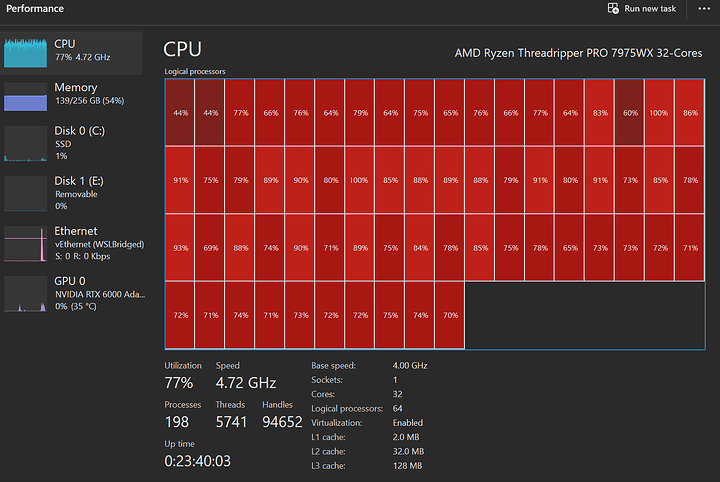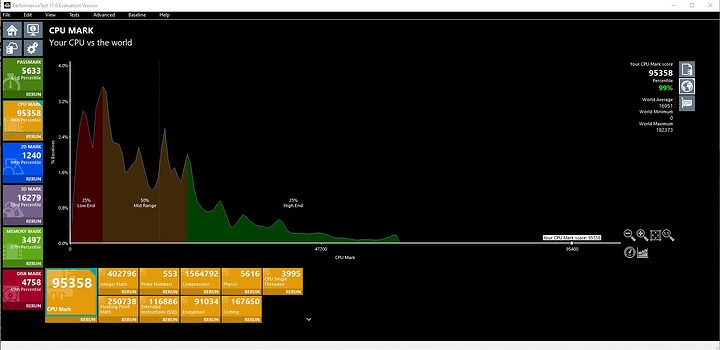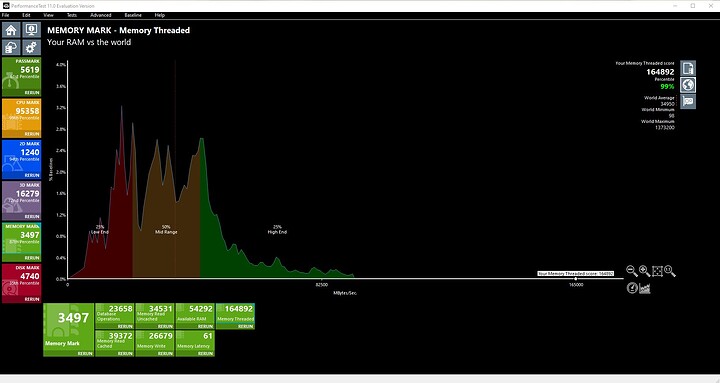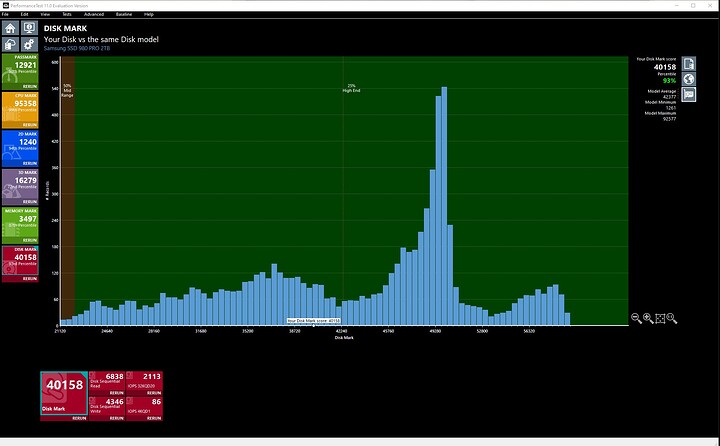Nothing special, just tried running one of my compute jobs and it popped about 2 hours into the run.
For posterity, the seasonic px-1200 is still running after a few days.
Still going strong, though I am sort of regretting not going for the 7985 or 7995.
Oh, also something interesting, on the silverstone power supply’s I would also occasionally get AD (pcie init) hangs on reboots, haven’t seen a single one on the seasonic. Initially thought it was just going to be a fact of life, but it seems like it was also related to the PSU.
Despite building machines for almost 30 years now, never really had to put much thought in the PSU before outside of budgeting power envelopes. Guess with this newer silicon we are getting to the point where things like voltage regulation and ripplage actually matter even in the mV range.
Random fact, at near full load with avx this machine was pulling about ~620 watts*. Draw without avx load is about 450~ watts*. No gpu load. With gpu load that would put me around ~900 watts, so can almost fit in a second gpu with on this PSU. Which is a lot closer than I thought it was going to be TBH
*Measured at wall
Thank you. This topic kinda lead to the decision to go for a bigger PSU (I have a topic running on this sub forum)
Iam curious to know if these boards allow standby to save power when afk?I have the Asus sage wifi trx 50 standard board ordered.
And sm about to build my first workstation.
It’s great to see your system running so well all things considered. I am wondering if I am having power issues myself do to consistent but sparse (At the moment) parity errors.
Have you been having any issues like this with your system since getting everything back on line after the powersupply issues were resolved ?
Your thoughts on the sensitivity of these newer threadripper platforms to power really has me thinking. My power supply seems to be fine but the power in my house defintely is old, unstable and likely needs to be redone. \
That said most all of my electronics perform just fine but these high end Threadripper chips might just be very sensitive to current instabilty of any kind , even with a working psu.
I returned my old Kingston 64gb sticks and picked up a 128 kit of 4 Gskill zeta ddr5 sticks. I have had the same issues on both. I have looked for the ram you currently have in your system but can only find it from kingston directly @ $1800 which seems a bit high, or from third party sellers on newegg and amazon. Frustrating.
Why are you regretting the 32 core version? It seems like it is the best of both worlds, fast single core and decent multi core.
Yes, and it is difficult to find applications whose performance depends linearly on the core count. I can name only CPU rendering and VM.
The main use of this machine is for signal processing and analysis which parallelizes well. Even though this machine took my 60 hour job runtime down to 30 hours I sort of wonder if I had got the 7995 if I could be looking at results in fifteen hours instead.
Don’t really want to do the actual math since if it’s true I’ll have to go spend another $10k. For now I’ll just be happy with the 50% improvement. Maybe when we get next gen thread rippers I’ll think about it.
Congrats on the improved performance from the rig. So it’s in windows doing basically one or 2 set task at any given time ?
Damn, been running a Phantks 750 W (seasonic OEM) on my 7960x with some odd issues, after reading this am looking for something better like GH1000. It may be that there are also high peaks or power spikes that need more derating.
Like for my memory VDDIO_S3 / VDDQ anything above the stock 1.1V is unstable on my AERO TRX50. The interesting part is that the memory runs stable at 6600mhz 128G with only 1.1V VDDQ/VDIO_S3 in 1:1 mode which for desktop DR DDR5 on AM5 is impossible, so the memory controller does appear to be good even with low IO voltage.
ADIA about 192G/s with 66ns, in intel MLC about 196G/s read, so the efficiency is impressively high as 6.6*256/8 = 211G/s gives >90% efficiency, really high for DDR.
FYI on the CFD only I got 22 to 23m depending on timings. Also if you try to run the CFD-EM one on windows, would like to see that if you can, check in task manager that its not using HT, on my PC windows puts all 24 threads onto 2 CCD’s, and leaves 2 CCD idle, unless I force HT disabled using process lasso. What makes no sense is that the CFD only bench does not do this and in fact runs faster without process lasso, very frustrating as I use this for COMSOL and want to find the fastest daily setup. There should be no difference here, this also makes we think this could be a bug in COMSOL 6.2, as it appears to depend on the model used.
Power supplies that are ATX 3.0 spec should be able to handle power excursions much better than the old ATX 2.x PSUs. The difference is like 125% vs 150%/200% power excursion tolerance between the two specs, depending on if there are native 12VHPWR ports on the 3.0 PSU or not.
The VDDQ voltage preference makes me think that the IO die is sensitive to voltage like it was on consumer Ryzen, where extra voltage would actually reduce memory stability fairly early on in the voltage ramp.
Those are pretty good memory bandwidth numbers considering the 8 channel threaddrippers are “only” achieving ~230-260GB/s copy with double the number of channels.
There definitely seems to be a bottleneck in the infinity fabric for high memory bandwidth numbers, Intel is running into this problem too with it’s mesh fabric, where the 4 channel Xeons have better memory scaling than the 8 channel variants.
I’m not sure what is going on with the scheduling, but I don’t trust Windows to do a good job at it. Linux is consistently producing better solve times than
Windows on the same hardware, usually in the neighborhood of 10-30% faster.
The CFD benchmark has less single threaded and memory intensive sections in it than the CFD-EM benchmark, so the later is going to be trickier to schedule for with all the context switching going on, but even then it should never be using two threads on the same core.
This seems like a situation in which setting NPS in the bios to 2 or 4 might improve performance because it’ll force Windows to spread out processes more evenly.
Hey fellas, I don’t want to derail this topic.
But can someone please help me over here?
Anyone know if there is something I need to hook up to fix this or is this powersupply about to die too?
Where are this messages coming from?
Hi there. I got yesterday the exact same threadripper cpu with the noctua cooler, same motherboard and ram kit set to a new built. Set a be quiet pro 1300W psu. It has booted, windows 11 installed. However, cannot seem to get all the RAM, first boot with all on, “only 64Gb”. Then tried different RAM configurations and managed to get up to 96Gb, and also up to 128Gb, so basically only 2/4 of the memory channels in the same motherboard side working. Anyone has any experience with this to share? Got three technicians headaches. The 8 different RAM sticks each seem to work separately on the working slots, so not a kit issue…
Welcome!
How certain are you that the CPU is making good enough contact with the socket pins? It seems like this socket is fairly sensitive to non ideal socket mounting pressures.
Also it seems like some people have been getting motherboards that need not only the heatsink mounting screws tightened to the proper torque but the actual socket bracket’s torx screws that mate with the back plate too.
Hi everyone!
I’m planning on buying & building the following specs in the following 2 months for a CFD & FEM workstation.
The specs are:
Operating System: Windows 11 Professional Edition
CPU Type: AMD Ryzen Threadripper PRO 7975WX 32-Cores
Motherboard: Asus Pro WS WRX90E-SAGE SE
Memory: 8xKingston KF560R32RBEK8-128 6000 (128GB RAM)
Videocard: NVIDIA RTX 5000 Ada Generation
NVME: SK Hynix Platinum P51 2TB X2
CPU Cooler: ???
Case: ???
PSU: X Mighty Platinum 2000 → Will upgrade to X Mighty Platinum 2800 when released
I would like any additional advice you might have on that build. Especially on which CPU cooler is best and which case do you recommend. The Intended use is CFD and FEM analysis for aerospace applications.
I’ve been building and modifying HPC servers and workstations for the past 6 years. But, It is a very expensive build and I’m paying, so I’m looking for any advice I can get before purchasing.




